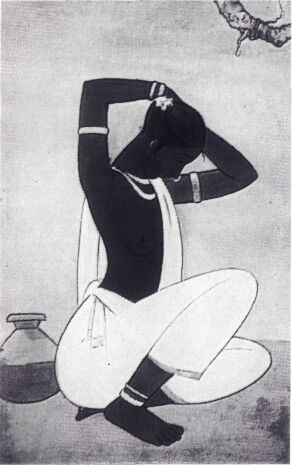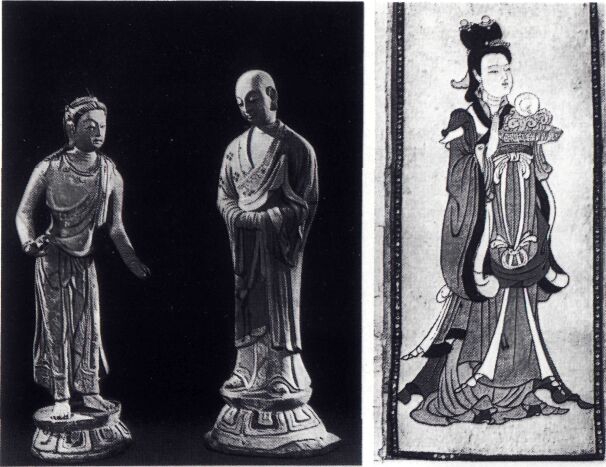
JAMINI ROY.
Toilet. India, 20th century
Second floor, rooms 368-371
The Hermitage has a rather small, but nevertheless interesting col-
lection of works of both old and contemporary Indian art. The collection
in the first section illustrates just one of the stages in the centuries-old
history of India-the period of the feudal Mogul Empire from the
sixteenth up to the nineteenth century. In the section devoted to contem-
porary art there are works by the outstanding artists of the present day
which have entered the Hermitage in recent years.
The items in room 368 acquaint the visitor with the art of various
regions of the country-Bengal, Southern and Central India, Gujerat,
the Punjab. Among these can be seen some small marble, wooden and
bronze sculptures of the sixteenth to nineteenth century, more often
than not representing the Hindu gods and the heroes of the old Indian
epics, Mahabharata and Ramayana.
From the exhibition in rooms 369 and 370 special mention should
be made of the large collection of seventeenth to eighteenth century
miniatures, including examples of the art of the Mogul, Rajputa and small
local schools.
Occupying an important place in the exhibition is one of the world's
finest collections of old Indian weapons. The offensive and defensive
weapons are extremely varied and include helmets of open-work gilded
steel, shields made from rhinoceros hide, pata swords with an armoured
covering protecting the warrior's arm, and kuttar daggers with the handle
at right angles to the blade. Also displayed are some chakra, ring-like
missiles with edges as sharp as blades, and side-arms with blades of
damask steel (the home of which was India) richly decorated with engrav-
ing and incrustation and inlaid with gold and silver leaf. Craft work of the
seventeenth to nineteenth century is represented by some wonderful
specimens of silk and velvet fabrics, carpets, ceramics, bronzes and ob-
jects made from ebony and ivory (rooms 369 and 370).
Room 371 contains a collection of modern painting, in which we can
note in particular the Fire Ordeal of Sita (water-colour on silk) by the
famous painter Barad Ukil, The Road to Mayavahti by Nandalal Bos,
Shacks and Sands by Bimal Das Gupta, A Meeting of Yogis and Spring
by S. Roerich, Returning Home by Madhava Satvalekar, Toilet by Jamini
Roy, and a bust of Mahatrna Gandhi by the well-known sculptor Chin-
tamani Kar. There is also a nineteenth century screen of exquisite open-
work ivory presented to the Hermitage by Jawaharlal Nehru.

Bodhisattva and monk from the monastery known as the "Cave of a Thousand Buddhas".
9th century
Moon deity, Khara-Khoto, 12th -13th centuries